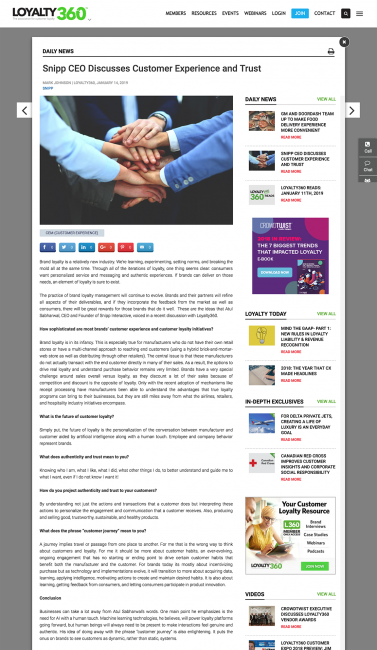Snipp CEO Discusses Customer Experience and Trust
Brand loyalty is a relatively new industry. We’re learning, experimenting, setting norms, and breaking the mold all at the same time. Through all of the iterations of loyalty, one thing seems clear: consumers want personalized service and messaging and authentic experiences. If brands can deliver on those needs, an element of loyalty is sure to exist.
The practice of brand loyalty management will continue to evolve. Brands and their partners will refine all aspects of their deliverables, and if they incorporate the feedback from the market as well as consumers, there will be great rewards for those brands that do it well. These are the ideas that Atul Sabharwal, CEO and Founder of Snipp Interactive, voiced in a recent discussion with Loyalty360.
How sophisticated are most brands’ customer experience and customer loyalty initiatives?
Brand loyalty is in its infancy. This is especially true for manufacturers who do not have their own retail stores or have a multi-channel approach to reaching end customers (using a hybrid brick-and-mortar-web store as well as distributing through other retailers). The central issue is that these manufacturers do not actually transact with the end customer directly in many of their sales. As a result, the options to drive real loyalty and understand purchase behavior remains very limited. Brands have a very special challenge around sales overall versus loyalty, as they discount a lot of their sales because of competition and discount is the opposite of loyalty. Only with the recent adoption of mechanisms like receipt processing have manufacturers been able to understand the advantages that true loyalty programs can bring to their businesses, but they are still miles away from what the airlines, retailers, and hospitality industry initiatives encompass.
What is the future of customer loyalty?
Simply put, the future of loyalty is the personalization of the conversation between manufacturer and customer aided by artificial intelligence along with a human touch. Employee and company behavior represent brands.
What does authenticity and trust mean to you?
Knowing who I am, what I like, what I did, what other things I do, to better understand and guide me to what I want, even if I do not know I want it!
How do you project authenticity and trust to your customers?
By understanding not just the actions and transactions that a customer does but interpreting these actions to personalize the engagement and communication that a customer receives. Also, producing and selling good, trustworthy, sustainable, and healthy products.
What does the phrase “customer journey” mean to you?
A journey implies travel or passage from one place to another. For me that is the wrong way to think about customers and loyalty. For me it should be more about customer habits, an ever-evolving, ongoing engagement that has no starting or ending point to drive certain customer habits that benefit both the manufacturer and the customer. For brands today its mostly about incentivizing purchase but as technology and implementations evolve, it will transition to more about acquiring data, learning, applying intelligence, motivating actions to create and maintain desired habits. It is also about learning, getting feedback from consumers, and letting consumers participate in product innovation.
Conclusion
Businesses can take a lot away from Atul Sabharwal’s words. One main point he emphasizes is the need for AI with a human touch. Machine learning technologies, he believes, will power loyalty platforms going forward, but human beings will always need to be present to make interactions feel genuine and authentic. His idea of doing away with the phrase “customer journey” is also enlightening. It puts the onus on brands to see customers as dynamic, rather than static, systems.


